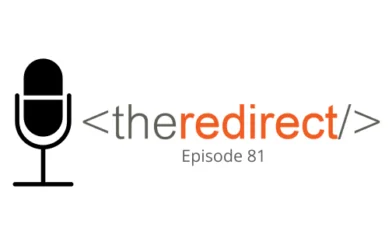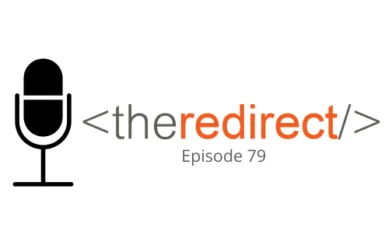Episode 12 / August 11, 2017
Listen Now:
In Episode 12 of The Redirect Podcast (in order of discussion):
- Designing content for the mobile-first index
- Direct traffic is dark traffic
- Where should your SEO team live?
- Disclosure and transparency in the agency/client relationship
- Google is testing ad tag placement in Google Local Pack
- Google Shopping ads integrated in YouTube
Designing Content for the Mobile-First Index
As a mobile-first index approaches, it’s important for site content to be “navigable, skimmable and digestible” on mobile screens. Best practices for this include the following:
- Table of Contents for the page to outline the content ahead.
- HTML headings (h1, h2, etc. – which can comprise sections of your TOC)
- Expandable (accordion) content. An alternative is tabbed content. These keep content organized, and prevent too much information crowding the page. It also allows a visitor decide what information they want to read and when.
- Filters, giving visitors the option to cut out large sections of the page they aren’t interested in reading.
- Summary or highlights, like a TL;DR like on news sites. (These are best positioned at the top of the page to help visitors decide whether to keep reading. We also discussed “Time to Read” being a part of articles.)
- Bulleted or numbered lists break up the visual flow and convey lots of information quickly.
These features will also convert well to desktop, creating a clean system (and helping with that potential “mobile first” desktop result). Read the full article at Search Engine Land: Designing Content for the Mobile-First Index
Direct Traffic is Dark Traffic
Traffic to your site labeled as “direct” or “(direct) / (none)” in Google Analytics isn’t always from someone typing or pasting the URL in a browser, or visiting from a bookmark. Other possible sources of direct traffic include links shared in an email, messenger app, or social media app. Because analytics programs can’t trace these visits back to their source, this traffic is called “dark traffic.” A large volume of dark traffic makes it difficult to report on a site’s analytics.
Read the full article at Seer Interactive: Direct Traffic is Dark Traffic, and That’s Ok
In the article, the author outlines dark traffic and presents some suggestions for categorizing it in analytics. However, even with these methods, you won’t have exact data to tie to individual sources.
One easy takeaway is to use campaign tags to help attribute traffic from social media and emails.
A suggestion for tracking traffic from offline channels, such as radio and billboards, is to use custom URLs that redirect to campaign URLs…but we’re skeptical. How often do people recall URLs from these sources, versus recalling the brand name and searching with that? Alternatively, you might consider coinciding these offline efforts with PPC campaigns based on brand recognition, when you otherwise wouldn’t bid on your brand name.
Where Should Your SEO Team Live?
A recent article at Search Engine Watch explains how an SEO team fits into different departments in an organizational structure. Read the full article: Does it matter what department your SEO team is in?
While there is no good or perfect answer for this question, the more integrated your SEO team can be, the better.
Companies that still do marketing and communications work in silos are at a disadvantage by not having the SEO in those departmental meetings/discussions. Keep in mind here that it’s not always about what the other departments can learn from SEO-minded folks (even though that’s true…); it’s more what the SEO can learn from other departments. When a new product is being developed, who is asking those “why” questions? What about the knowledge held by customer service and front line teams, or communications staffers? Having a solid understanding of those common end user questions and/or concerns can be huge for an SEO.
Disclosure and Transparency in the Agency/Client Relationship
This topic is important topic to us. [Related: Delivering Honesty and Ethics in SEO]
Clients should not be left in the dark when it comes to an agency’s work for them and the assets associated with the work. An ethical agency will be transparent about the work being performed and will share the keys to the kingdom with the client. Disclosure is everything. Read the full article at Search Engine Land: Disclosure and Transparency: The Agency/Client Relationship Twins
On a related note, the client/agency relationship should always be built on open communication. Even if a client says they don’t need the monthly report that’s part of your services, send it anyway. Over-communicate to deliver value to your clients, as well as a CYA measure if your work is ever called into question.
Google Testing Ad Tag Placement in Google Local Pack
Google is testing in the wild, adding ad tags to listings in the “local pack” (AKA map listings). Also noted is the placement of the ad tag; depending on if a star rating is present, the ad tag could appear next to the star rating, or lower, next to the address. Read the full article from The SEM Post: Google Testing Various Ad Tag Placement in Google Local Packs
Google Shopping Ads Integrated with YouTube
Also spotted in the wild: Google Shopping ads are integrating more closely with YouTube videos. Jason shared a personal example of watching DIY videos and noticing ads for products very closely related, if not spot on, to the context of the video. We’ll keep an eye on this and share any developments in future podcasts.
Thanks for tuning in! To catch future episodes of The Redirect Podcast, subscribe on Soundcloud, iTunes, or Stitcher.




